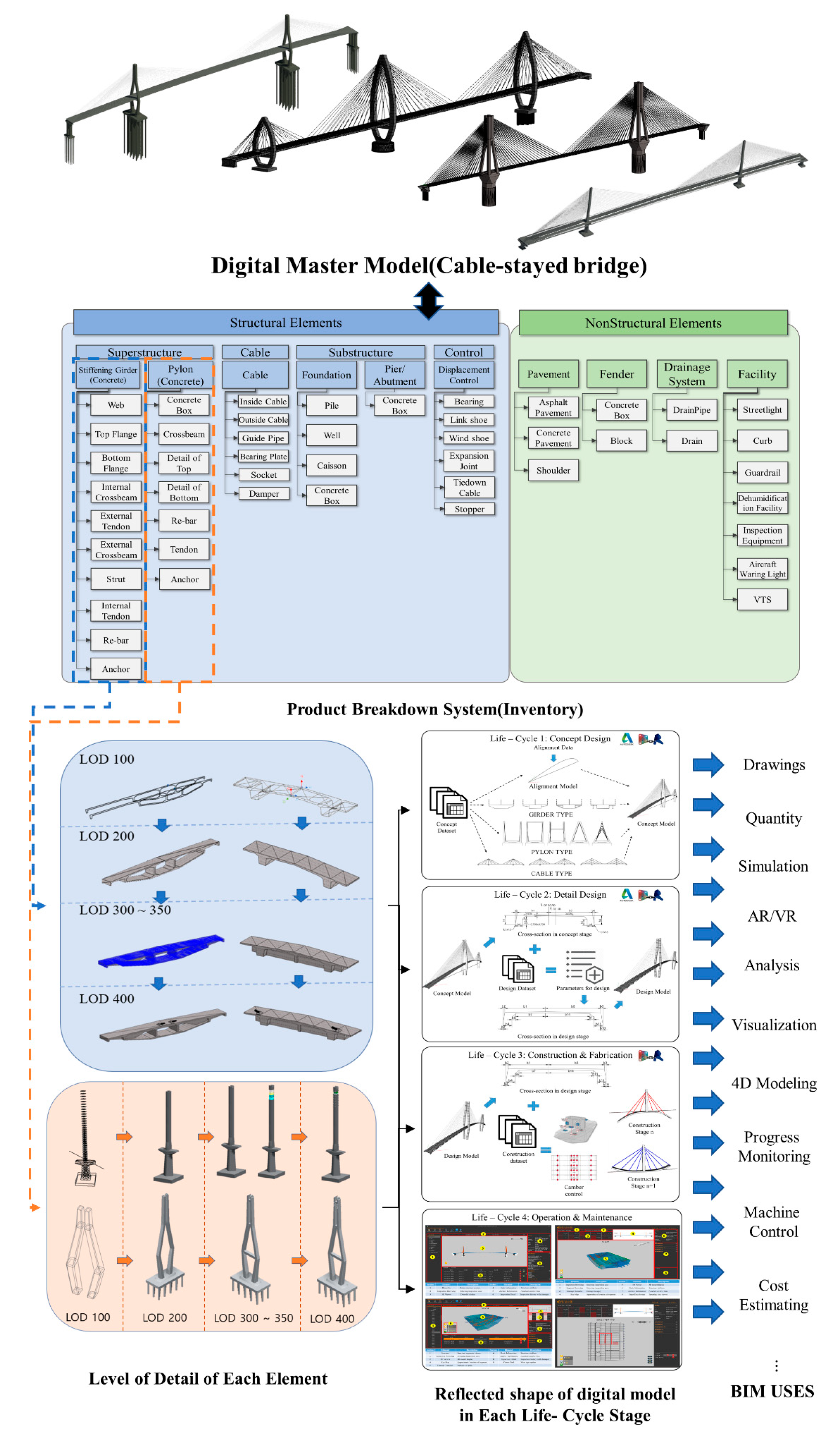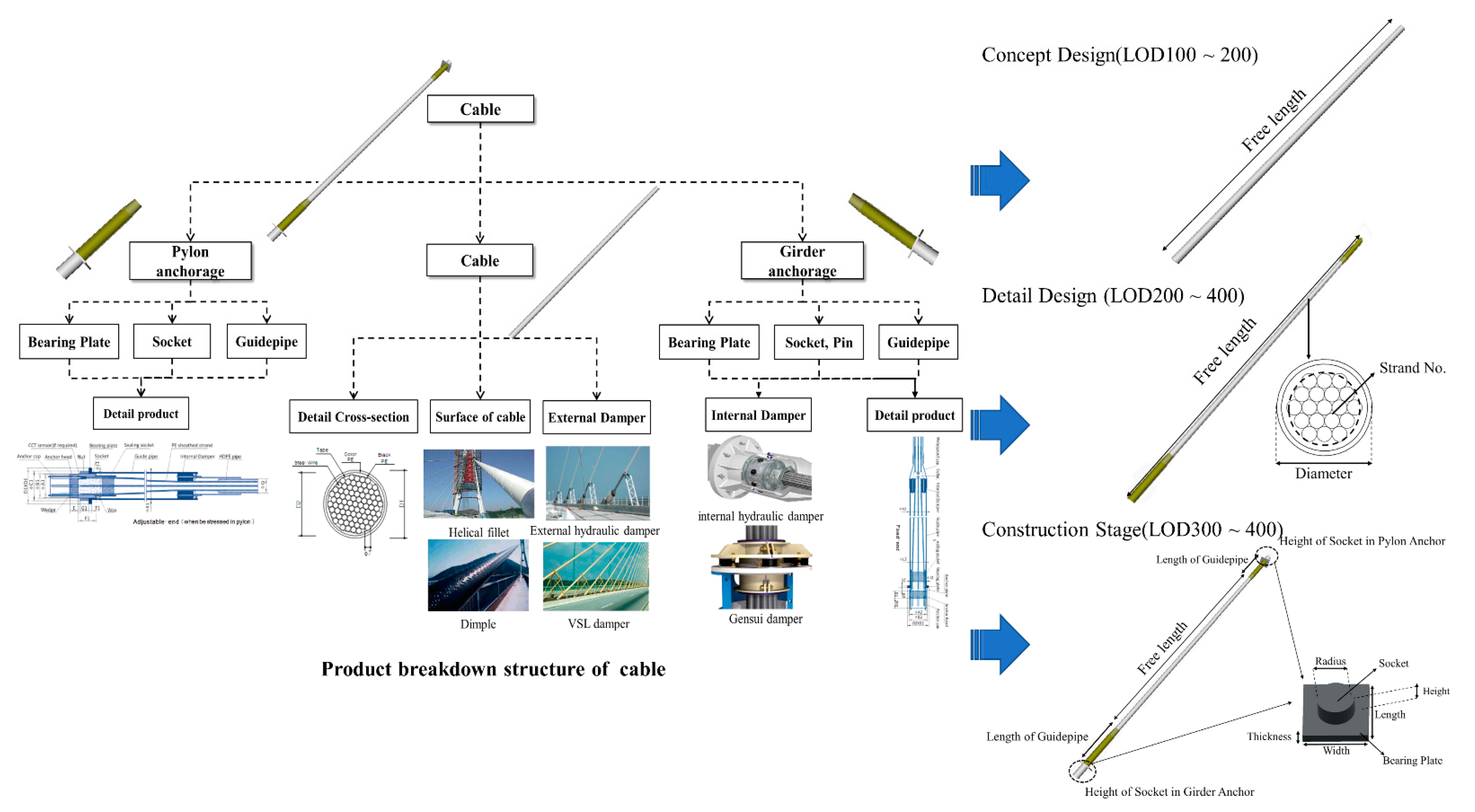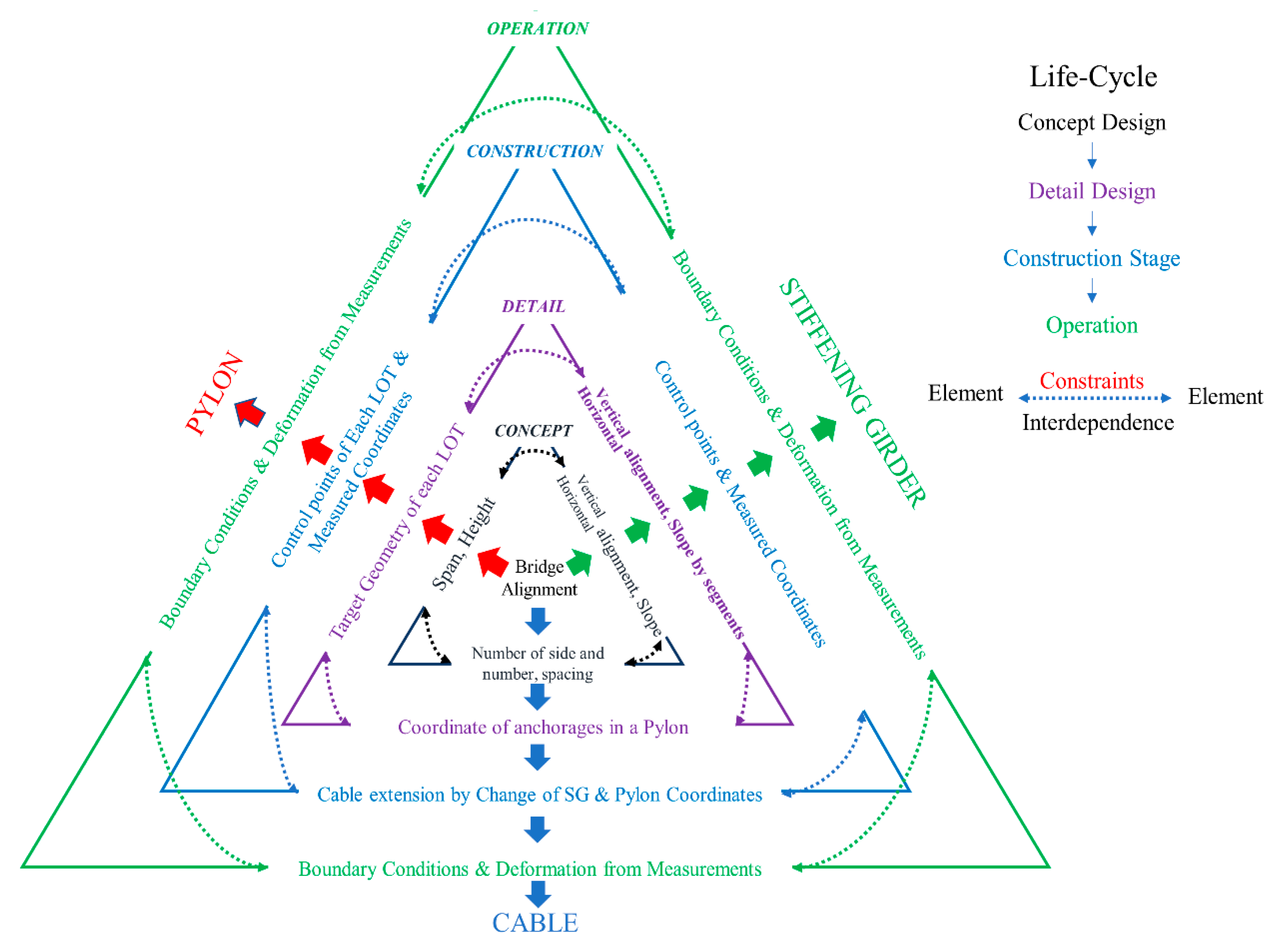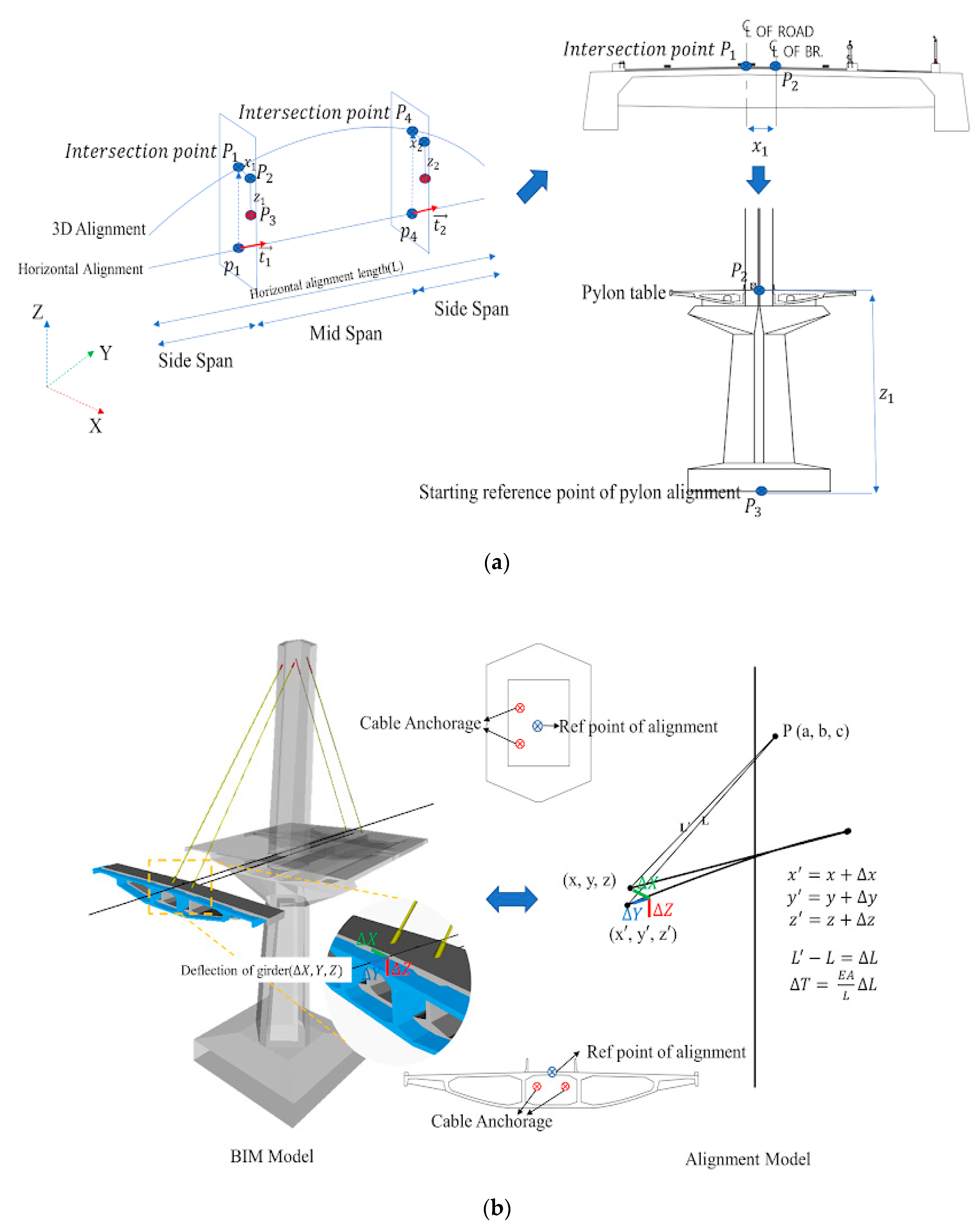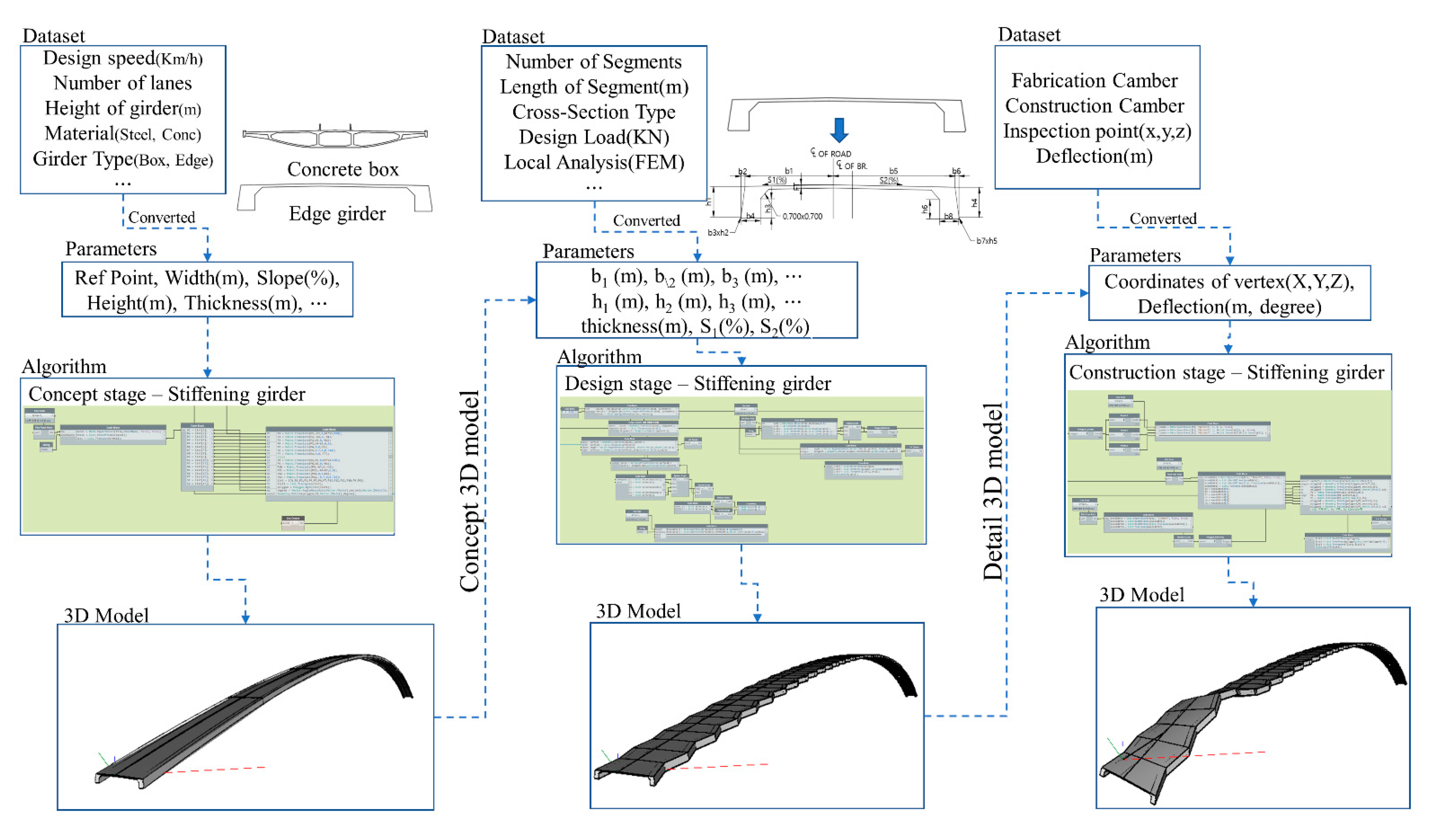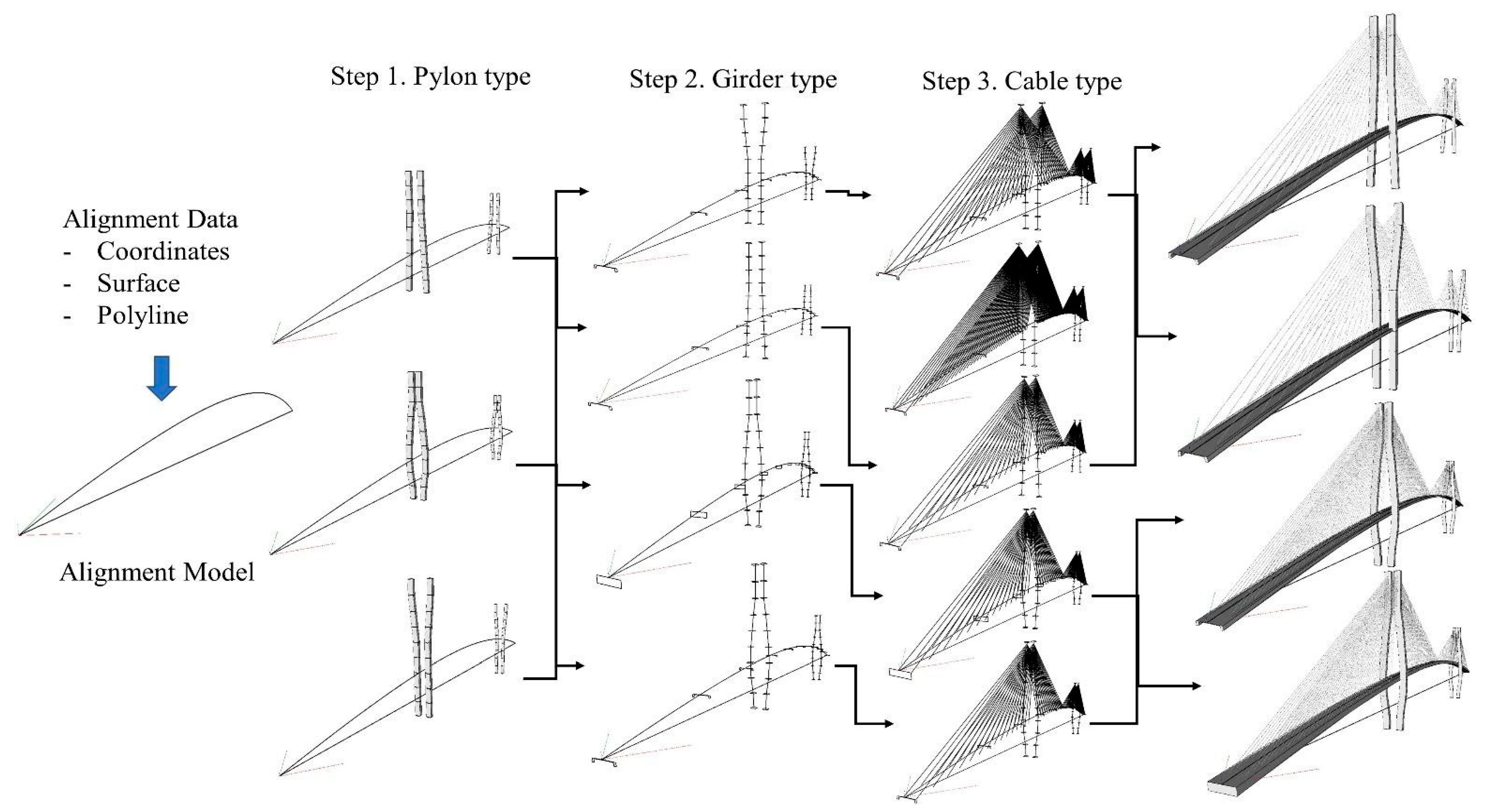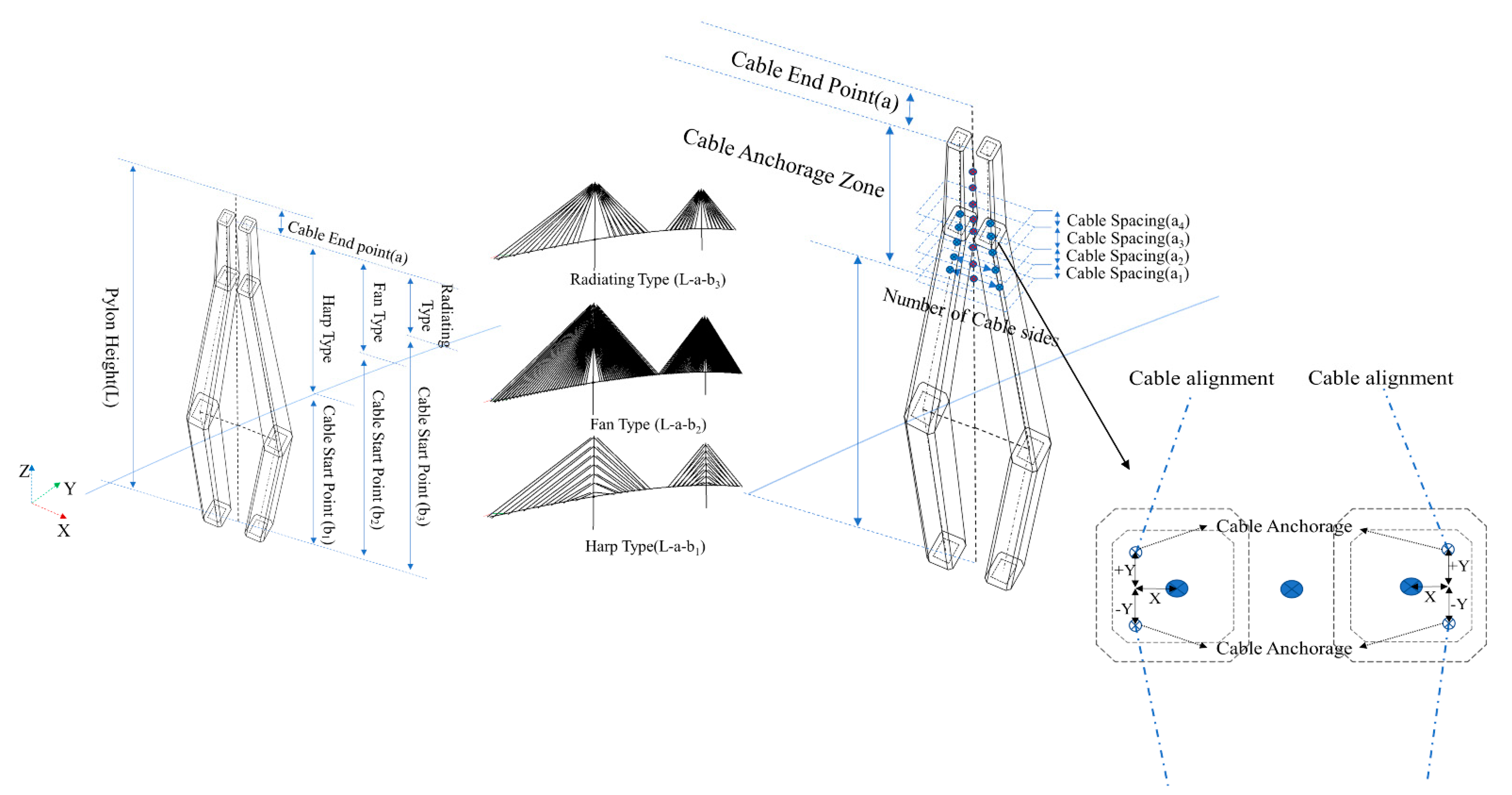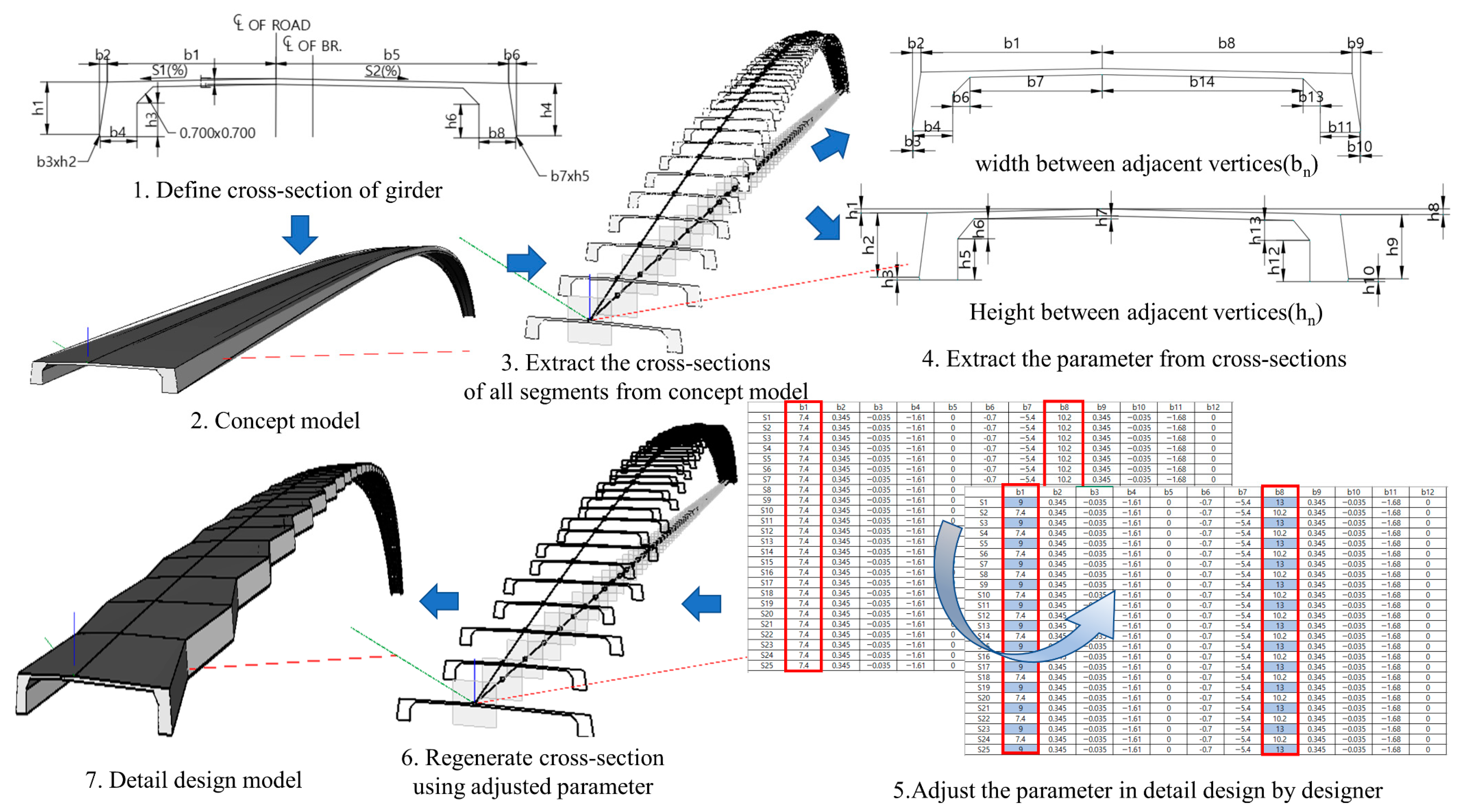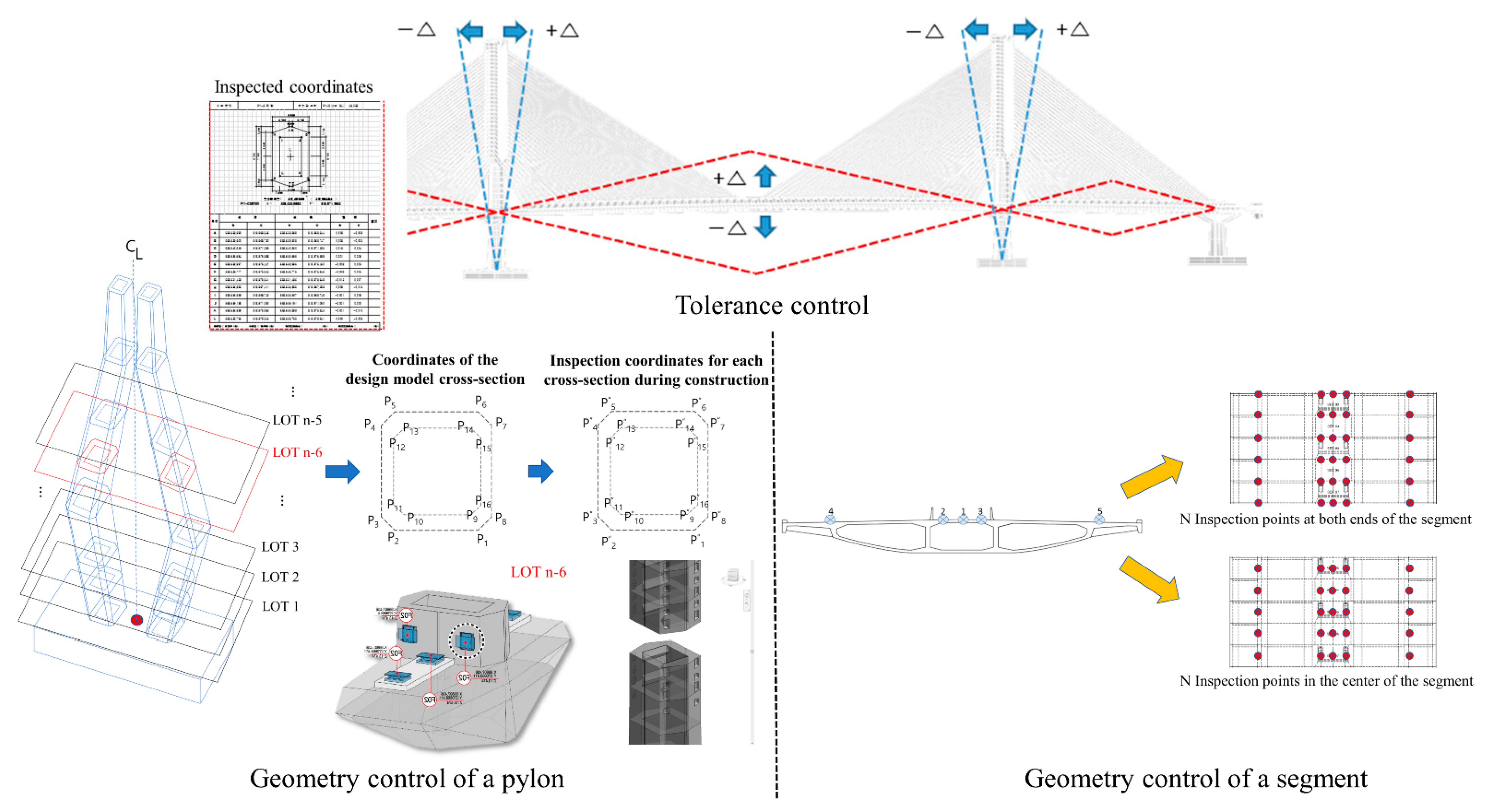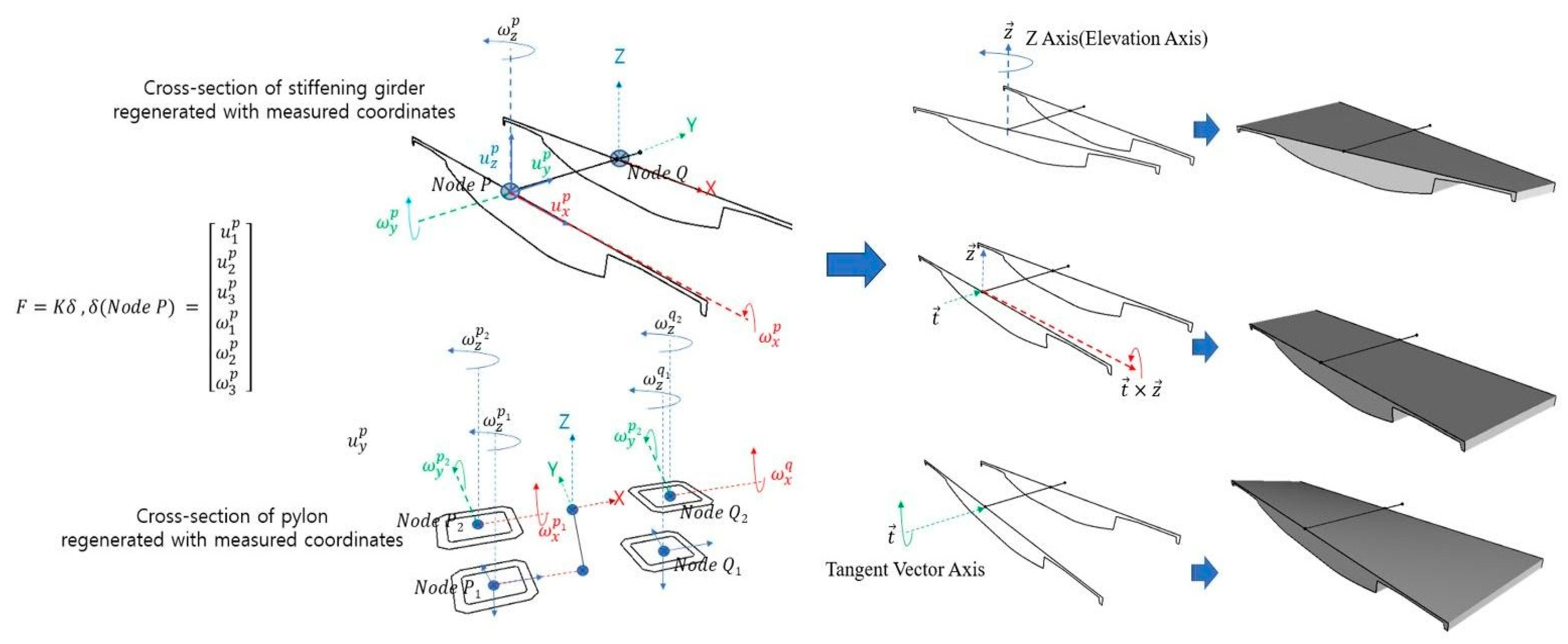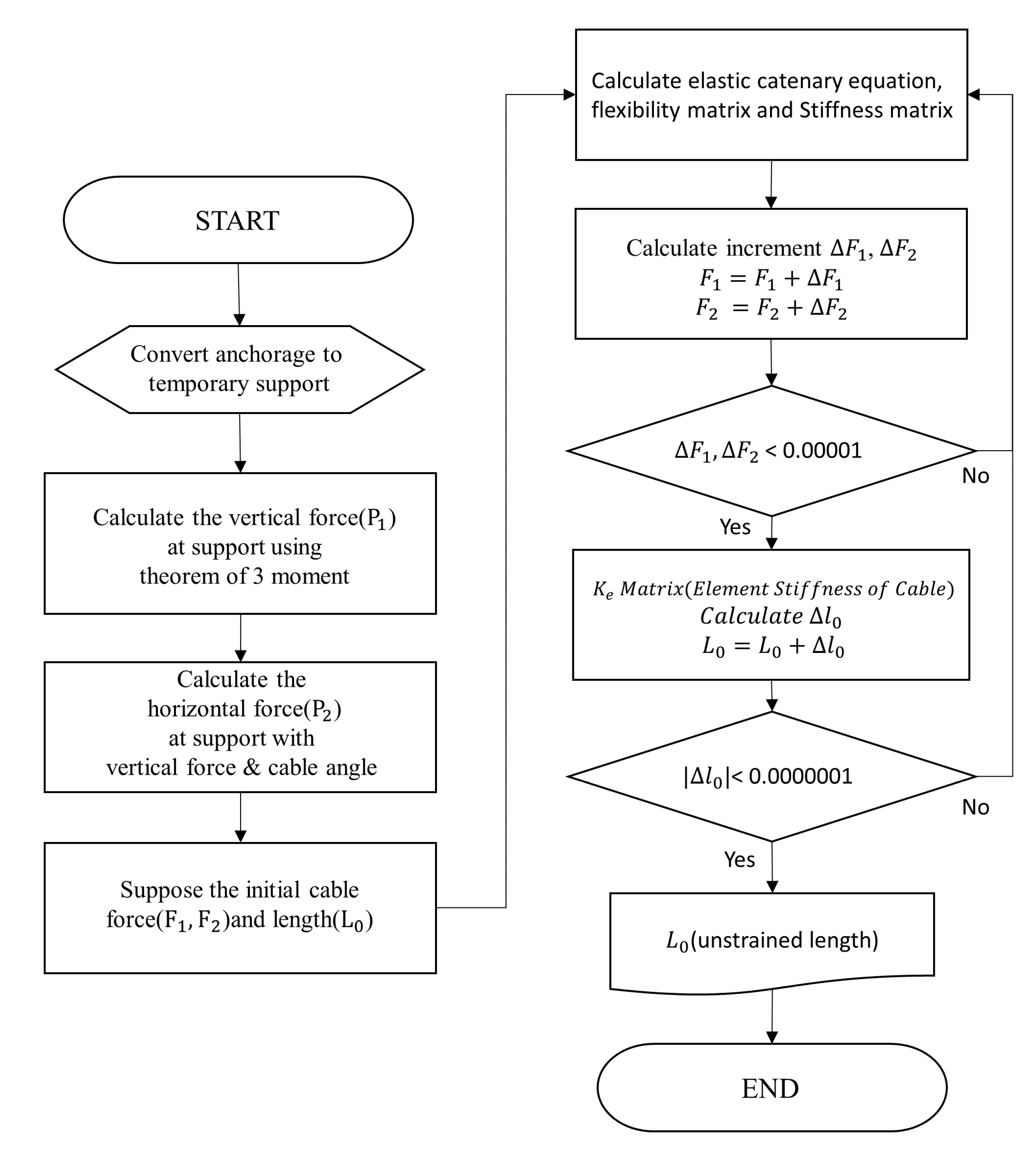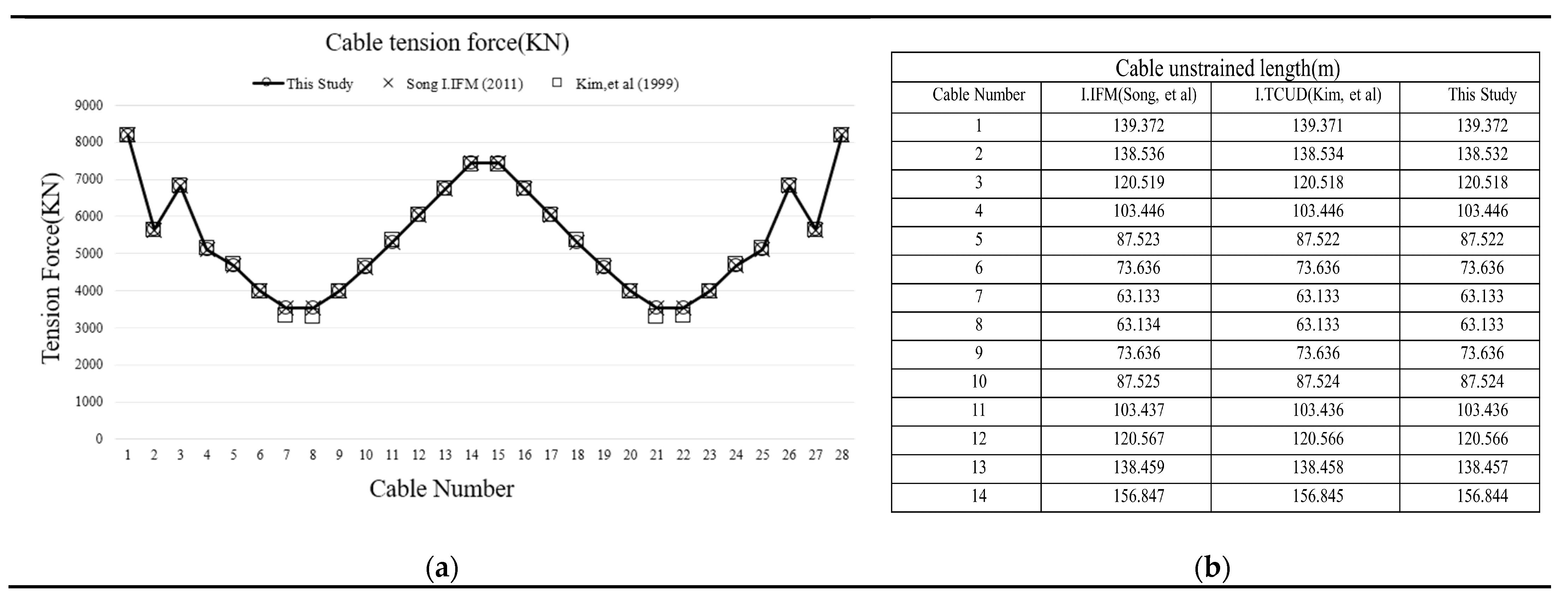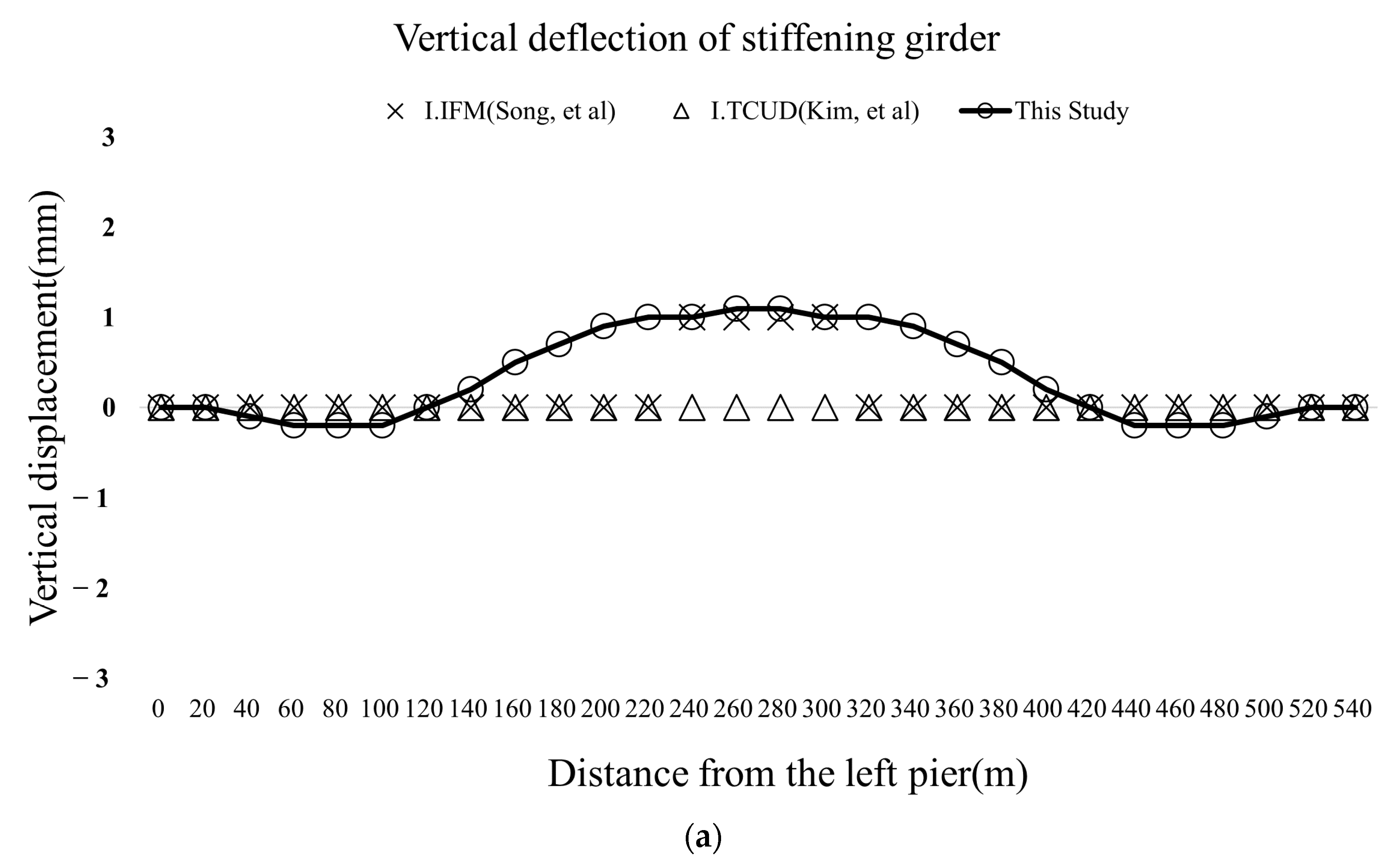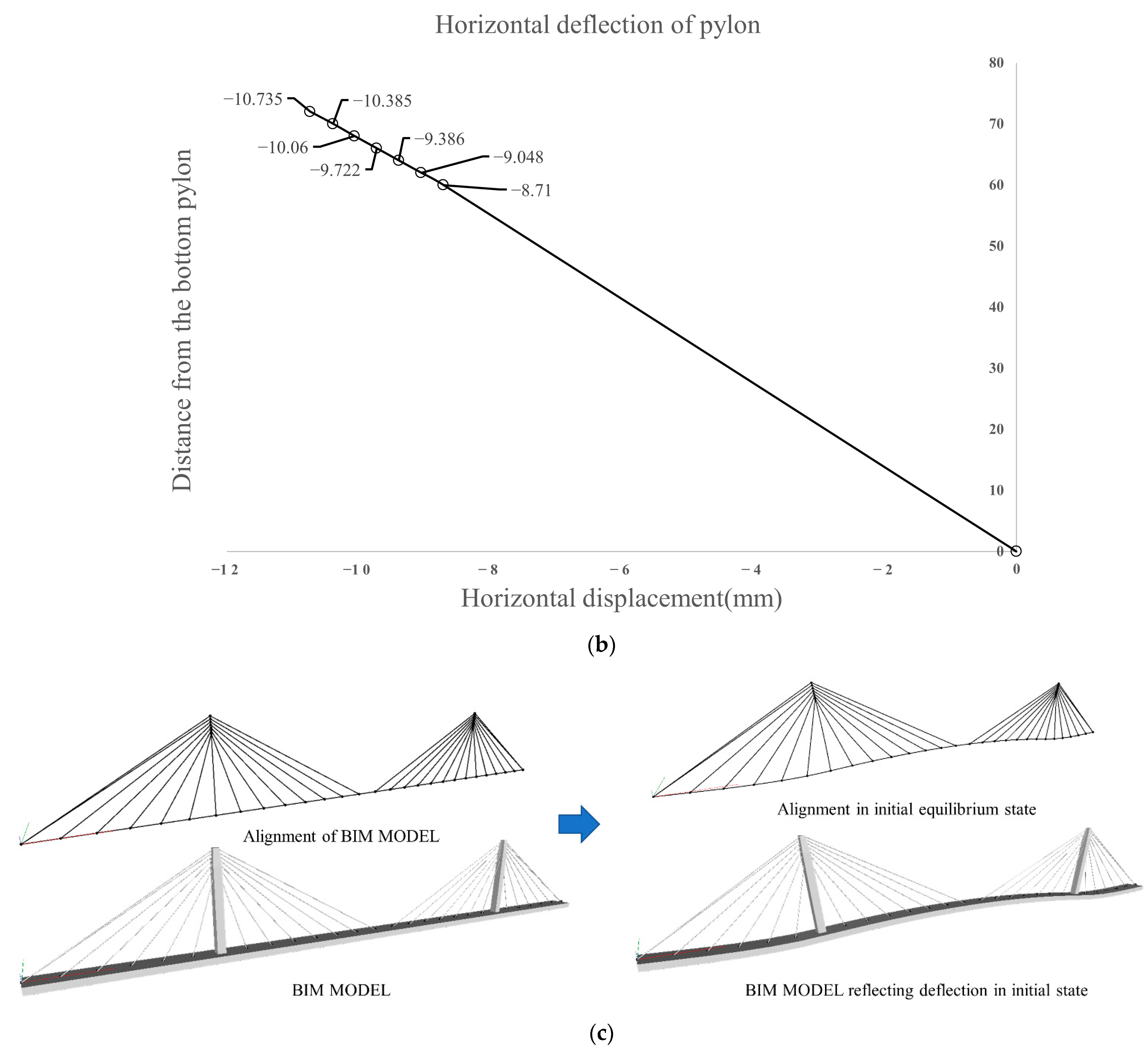1. Introduction
In the construction industry, BIM (building information modeling) has been implemented in numerous major construction projects for an improved collaborative working environment. Many countries are mandating the implementation of BIM in construction projects. Recognizing the advantages of BIM, generally, BIM tools are widely used today for document creation. However, today, construction companies and engineers need to recognize the real value of BIM as a database and modify its use accordingly. The next phase in BIM adoption should be focused on data generation and its uses [
1]. In a traditional construction project, a bridge is modeled, and the information for design and construction is obtained separately. Fragmented information delivery is commonly considered as the primary cause of low productivity. Efforts to adopt the latest manufacturing industry-related technology, such as robotics, are actively progressing [
2]. To communicate with machines and for data analytics, the current BIM practices should be further aligned towards data-driven engineering. Through the creation of a suite of standardized objects using algorithms and databases, valuable data can be generated in the construction industry.
In the design of a cable-supported bridge, the mechanical behavior depends on the geometry of the cables. Geometry modeling and information architecture have been widely introduced for the different BIM use-cases in bridge engineering [
3,
4,
5,
6,
7]. Parametric modeling and alignment-based object-oriented modeling is essential for authoring a digital model. By applying a set of parameter databases and appropriate algorithms, the entire bridge model can be realized without any discontinuity through the construction project stages [
8]. When there is an agreement to share the digital models and their data architecture, collaborative work among various stakeholders must be realized across different stages of the project, even during the operation and maintenance stage.
The Industry Foundation Classes (IFC) represents a standardized open data model that meets the information requirements of the construction projects and is adopted in many BIM solutions. ISO 19650 is the international standard for managing information delivery across the entire life cycle of a construction project using BIM. It contains all the principles and high-level requirements for organization and digitization [
9,
10]. The IFC-Alignment and the IFC-Infra Overall Architecture projects provide good foundations for the modeling of the linear civil engineering structures. The IFC-Bridge project was officially started by buildingSMART International [
11]. The three-dimensional (3D) alignment-based bridge modeling was proposed by many researchers [
8,
12,
13]. Current BIM projects in bridge construction encounter difficulties in the sharing and delivery of information models between the BIM solutions due to the lack of interoperability. For automatic or machine-based fabrication needs, improved and more generalized data-driven information delivery is necessary. For example, DfMA (design for manufacturing and assembly) requires data interfaces between the digital models and robotic operation data [
2].
Tension structures are designed mainly in three steps: form finding, load analysis, and pattern layout [
14]. Once the initial equilibrium shape or target configuration is decided, the behavior of the cable structure under various load combinations must be checked to ensure all necessary limit states. A cable structure has no unique undeformed configuration corresponding to the equilibrium configuration under dead loads because the lateral stiffness of a cable is defined based on the applied tension [
15]. The initial equilibrium configuration under a dead load can be determined by the target configuration under dead load (TCUD). The initial tension forces and unstrained lengths of cables can be determined by TCUD analysis. The geometric constraint method and the initial member force method have been adopted for the TCUD analysis. This is the most distinctive mechanical property of cable structures, resulting in the challenging task of using BIM practices to define the geometry of digital models for cables. Lonettie and Pascuzzo investigated the structural model by combination of a finite element analysis and optimization procedure [
16,
17]. Model-based design can be accomplished when a digital modeling procedure includes design analysis.
Interoperability between BIM models and finite element analysis (FEA) models is a challenging problem in civil engineering because most design codes rely on the member-based design verification. The 3D digital objects need to be converted into two-dimensional (2D) plane or frame elements to derive the member forces. In the design process of a bridge, parametric modeling of 3D-object models for structural analysis of reinforced concrete columns was proposed [
18]. Design parameters were utilized as information for the FEA. The importance of complete interoperability between BIM and FEA determines data exchange, wherein certain simplifications are made, and the interaction can be performed in both directions. This means that the BIM model transfers digital data into the FEA considering all the necessary parts needed for the analysis, and as FEA is performed, the BIM model is updated simultaneously. Most of the BIM solutions already enable interoperability of BIM and FEA; however, certain issues have still not been resolved. In particular, problems related to nonlinear structural behavior according to geometric configurations, such as cable-supported bridges. Because of incomplete interoperability of BIM and FEA, engineers apply them separately, which in turn impairs the design efficiency [
19].
Due to the complexity of the cable-supported bridge projects, a design strategy with multiple goals is generally required. A design that is supported by data from previous experience or from another discipline is called a data-driven design [
1]. In particular, these designs enable engineers to modify and refine the early design concepts in an iterative manner based on the simulated design outputs and functionality, while constantly gathering project data for future usage in a common data environment (CDE). Therefore, engineers need to be able to share and deliver data for the collaborative project delivery. Date-driven engineering essentially requires mutual agreement for the definition of the data models according to different uses. The algorithms for digital objects are significant when considering the manner in which engineers use data and the reason behind it. This is the common agreed-upon standard that makes the processing, presentation, and interpretation of data possible. Multiple efforts have been made to utilize the submitted BIM models and the corresponding databases for bridge maintenance [
4,
5,
6,
20].
In this study, model generation algorithms of the main members of a cable-stayed bridges are suggested. Through capturing knowledge of current practices related to cable-stayed bridges during design and construction, datasets and constraints of the digital models are derived. To overcome the rigid geometry of BIM models, the algorithm considers the deformation from the analysis of the construction stage results. In this study, information delivery, based on the suggested methodology, is applied to a cable-stayed bridge.
2. Definition of Digital Models for Design
Model-based information delivery requires consensus on the definition of digital models among the project participants at the start of the project. Current BIM practices commonly produce documents and 2D drawings from the models. Model-based design delivery was implemented in a tunnel project in the UK [
21]. In a CDE, each information container has a unique ID, classification, and status. Cable bridge projects are complex and the models serve various purposes. Therefore, it is necessary to define digital models for collaborative working and data transfer among the participants. Mechanical features of the cable structure should also be considered in the model authoring algorithm. According to product breakdown structure (PBS) of the entire life cycle uses of the models, digital models of the main members are illustrated in
Figure 1. Models with different levels of details (LODs) are defined as a set of algorithms for the main members. Design parameters and constraints (or rules) are defined as the databases. A master digital model for a cable-stayed bridges is basically defined to be representative of LOD400.
Each digital model has a set of geometry parameters, properties, and algorithms with constraints such as alignment-based and rule-based relations. Three-dimensional models are deformable considering the interoperability with the FEA or for measuring coordinates through geometry control during the construction phases. Engineers without experience in BIM practices can use the dataset to modify the digital models for their own purposes. Model definition needs active involvement of experienced engineers to realize the use-cases through digitalization of the current domain knowledge of cable-stayed bridges. Once the databases and algorithms to generate the digital models are shared in a project, information delivery only requires exchange of datasets between participants or phases. As-built models can be divided into individual model libraries for designers which feature fewer errors and require less time to search information.
2.1. Inventory and Code System of Physical Elements
According to the defined PBS of a cable-stayed bridge, digital models of cables are defined as illustrated in
Figure 2. The stayed cables connect stiffening girders and a pylon and have anchorages at both ends. The geometric model of the cable depends on the relative positions of the anchorages that feature elastic deformation values upon varying the tension forces. Therefore, the cable is a slave element that has a variable length based on the locations of the anchorages at the stiffening girder and pylon. Guide pipes belong to each part of the girder and the pylon and have variable angles according to deformation of the bridge. Unstrained length and extension of the cable provide tension force to the cable. Anchorage components are mostly commercial products and have the specifications and properties such as, material, dimensions, and section area. LOD200 is appropriate for the conceptual design stage, while a higher LOD is appropriate for the detailed design stage and construction stage. During construction, measuring positions for geometry control are generally located at the end of the guide pipes. In the modeling algorithm of a cable element, the length between the ends of the guide pipes is considered variable.
2.2. Positioning Elements of the Main Members of the Cable-Stayed Bridge
A cable-stayed bridge model consists of alignment-based models, such as the stiffening girder and point-wise objects (for example, anchorages). Positioning elements are defined by the 3D alignment data including the profile and elevation. Positional data are defined for the stiffening girder, pylon, and cables. After assigning a reference position of the alignment, the stiffening girder models are defined based on a transverse slope and profiles. According to the designer’s choice, cable elements are distributed in various arrangements. Positioning elements should consider the variation of the cable arrangement. Positioning elements for a pylon also include variation of the anchor locations and casting Lot units. These initial considerations allow for active re-visioning of the digital models during the detailed design or construction phase.
Capturing domain knowledge on the design and construction of a cable-stayed bridge is a challenging task. In this study, an on-going project was chosen to obtain the essential definition of the positioning elements. Particularly, construction engineers have planned a detailed erection plan and a measuring plan for the geometry control. In each stage of the erection of a stiffening girder and cable tensioning, the measuring locations are included in the definition for real-time revision of the digital models. Positional data—that are obtained from an FEA or a monitoring system during the operation and maintenance—are also useful for the expression of the deformed shape of the bridge. For interoperability among the digital models and FEA models, the positions for boundary conditions, such as bearings, need to be included in the definition, as represented in
Figure 3.
2.3. Constraints Condition among Bridge Members
In cable-stayed bridges, substructures and superstructures have constraints, according to the boundary conditions at the supports and pylon table location. These constraints influence the mechanical behavior, resulting in interconnected deformation.
Figure 4 provides the definition of the constraints along the position coordinates. The master–slave relationship is essentially determined for algorithm development. For the constraints between pylon and stiffening girder, the roadway alignment is assigned as a master element and the substructures are considered the slave elements. Locations of the substructures defined by the bridge alignment positions are considered in the model generation algorithm, as shown in
Figure 4a. Cables are slave elements, while the stiffening girder and pylon are master elements. The relative change of the two coordinates of the anchorages is modeled as the deformation of the cables, as shown in
Figure 4b. Cable tension forces can be estimated by the extension of the cables; this will be explained later in this paper.
3. Algorithm of Digital Model Generation
3.1. Overview
For different stages of a bridge project, interoperability across different software packages is low due to incompatible data file formats. BIM deliverables are not so effectively used for maintenance tasks because there is a loss of data and information during project handover [
22]. To overcome the current problems of model sharing between the participants across project phases, algorithms of digital model generation and their datasets are developed. The algorithms are implemented by the DYNAMO software from Autodesk. A bridge component has three digital models of LOD 200, 300, 400 for different purposes. Data-driven information delivery and effective revision of the models is accomplished through this combination.
Figure 5 shows the algorithm of a stiffening girder for different stages and their datasets. Modularized algorithms are assembled to build an entire bridge model. Data analytics, including FEA, can be linked with the datasets and the data derived from the geometry information. Designers handle the datasets to generate digital models without any expertise per se of BIM solutions. By sharing the templates of the datasets and the algorithms, data storage and delivery becomes much more efficient. The algorithms are flexible, and therefore, more functions—such as quantity take-off and generation of 2D drawings—can be added.
3.2. Concept Design Stage
During the design of a bridge, design activities occur at various levels across different disciplines. Data-driven design tools support the early design by rapid development of the design variants. This new approach will replace the various one-to-many and many-to-one data exchanges in a design project [
22]. The integration of design intention and efficient data sharing is achieved through a digital master model as a series of related and interconnected digital objects.
Figure 6 presents a modeling process for the conceptual design of a cable-stayed bridge. Various alternatives can be chosen by the designer through the modeling algorithm including the expert’s experience of the conceptual design process.
In a conceptual design stage of a cable-stayed bridge, various design alternatives, including the bridge alignment, are created and discussed in terms of the different aspects to satisfy the client’s requirements. Bridge alignment is defined as an alignment model with reference coordinates at both ends of the bridge and surfaces with slope definition to ensure roadway alignment. These data are the main master information for the modeling algorithms with parent–child relations. The arrangement of span lengths is decided by a designer and the positioning coordinates for bridge substructures are derived from the algorithm. From the coordinates and the 3D alignment curve, the normal and tangential vectors are derived to define the reference points for the modeling of a pylon and piers, as shown in
Figure 4a. Further, the algorithm also enables a designer to add constraints on the digital models for strict design requirements, such as bridge clearance.
Considering the thickness of the pavement, in addition to the height of the stiffening girder and bearing, the reference coordinates for the pylon and piers are defined. Thereafter, the position lines are defined to generate the substructures with different section profiles. Each location with the section change is defined as the position coordinates. The algorithm for each object uses a relative coordinate system (RCS), while the entire bridge has an absolute coordinate system (ACS). The reference position of a bridge will change the RCS of each object into an ACS for a roadway. The angles between the alignment of the superstructure and the substructures are considered in the algorithm to rotate the section of the substructure along the reference lines, as shown in
Figure 4b. Through this process, the basic conceptual design model is generated.
The main parameters of a stiffening girder in the conceptual design stage are the type, depth, width, and slopes. The stiffening girder has typically different sections at the supports, pier table, and anchorages. The algorithm includes parameters to define the sectional changes along the length of the bridge. For the local coordinates for the generation of the stiffening girder, the Y axis is along the bridge, the X axis is along the transverse direction of the deck, and the Z axis is along the elevation. The planes for the definition of the girder are defined by the local coordinates. Each dimension of the girder is considered as the parameters to generate the digital model in the algorithm. When the digital objects are combined to build a total bridge model, the section in the local coordinates will rotate, considering the relative angles with respect to the global coordinates of the bridge.
In the stiffening girder, there are cable anchorages that are determined by the number of cable planes and cables. Some parts, such as in the pier table, are the key segments that do not have the anchorage details. The spacings of the cable are determined by the main parameters in the algorithm. For the case of the requirement of additional cables, such as for the back-stay cables and in the case of an uneven arrangement, the algorithm also functions to add more cables. The position coordinates of the anchorages are generated from the coordinate system. The relative position of the anchorages in the stiffening girder can be changed by parallel movement in the transverse direction. In a cross-section, the cable system is commonly arranged in one vertical plane above the center line, in two vertical planes at the edges of the stiffening girder or in two inclined cable planes. This algorithm allows a designer to choose a single-plane or double-plane cable-stayed bridge.
For the system of stay cables, two main configurations are generally found: the fan system and the harp system. A designer can choose a system and arrange the number of cables and locations of the upper and lower end anchorages to generate the cable models, as shown in
Figure 7. From this definition of parameters, the positions of each anchorage produce the coordinates to define the cable elements. When the section profile of the pylon is changed, the positions are revised automatically by the algorithm. The sections of the cables are added to generate 3D models along the axis of the cable that connect two anchorage locations.
3.3. Design Development Stage
In the detailed design stage, the conceptual model is revised to encompass more details for construction methodology and sectional dimensions. Analysis of the bridge models under static and dynamic loadings is also interoperable with the digital models through the position elements and their constraints. For example, the pylon is divided into segments considering a casting plan (LOT module). A dataset for the modeling of the pylon is generated and will be used for the construction stage. At each node of the plane with the pylon section, normal planes of the pylon are defined. These data will be used for the geometry control of the pylon during the construction stage, as shown in
Figure 8. For the analysis, sectional properties at these planes are calculated to obtain essential data. A designer handles the model by changing the parameters through the XLS or XML file format.
The stiffening girder has a segment length that considers the construction equipment and conditions of the construction site. After segmentation of the girder, the reference points for the generation of girder objects are generated as shown in
Figure 9. At each reference point, a normal vector is defined representing a surface of the section that is also utilized as nodes for the analysis and geometry control. Variable sections can be generated by two section profiles at each end node. Datasets for the generation of the stiffening girder can be stored as a database. Constraints for the section definition are defined by the node coordinates. A cable object consists of a part of the guide pipes and free-length parts. Reference coordinates for the generation of cable objects are obtained from the models of the stiffening girder and the pylon.
3.4. Construction Stage
One of the most crucial tasks in the construction of a cable-stayed bridge is the construction geometry control. The bridge is flexible, and deformation occurs according to each erection step. The digital models for the detail design stage are based on the parametric modeling with constraints to accommodate the deformation. By capturing the current knowledge on the geometry control through the expert’s opinion, multiple measuring points are added in the models, as represented in
Figure 10. When the measuring data are obtained, the geometry of the digital models is revised in real-time. The sliding form of the setting coordinates are also determined from the comparison with the designed alignment and the measured geometry. Construction engineers can accumulate the process with more systematic information with respect to deformation and cable forces. In the utilized precast segmental construction method, the preassembly simulation is useful for the geometry control using fabrication models. The obtained data on the cable forces and deformation are used for the operation and maintenance tasks.
Conventionally, the free cantilever method is utilized for the cable-stayed bridge. The structural safety is assured by the strict geometry control and measurements. After the initial equilibrium state under a dead load at the final stage is determined, the construction geometry is decided by a construction stage analysis based on the initial equilibrium state. During the construction stage, the adjustment of cable forces is continuously performed by comparison with the measured geometry and analytical results. The camber values from fabrication and erection are considered for the geometry control. As shown in
Figure 10, the measuring points that are determined by construction engineers, are included in the modeling algorithm for rapid revision of the digital models. For the 3D frame analysis of the construction stages, the locations of nodes are control points to accommodate the deformation by the analysis. The deflection and rotation of each member are used for the generation of the bridge model during the construction stage, as shown in
Figure 11. The measuring positions for the cables are ends of the guide pipes. From the defined constraints between the anchorage locations in the pylon and the stiffening girder, the cable objects are automatically revised. These extension values are used for the calculation of cable forces.
The suggested modeling algorithm was provided to improve BIM practices in a domestic bridge construction (Goduck Bridge in Seoul). The bridge has a main span of 540 m and six lanes. Stiffening girders of concrete box section uses high strength concrete. The international bridge construction project in Myanmar (Dala Bridge in Yangon) is a 690 m long cable-stayed bridge. Digital models for this bridge were created by the proposed algorithm. Through these pilot applications, engineers utilized the digital models with minimum delay to follow the construction stages. Construction engineers only create datasets from measurements of geometry, then they obtain revised digital models.
4. Definition of a Mechanical Behavior of a Cable
In the design stage of a cable-stayed bridge, only the deformed shape of a cable structure under dead loads is predetermined. The deformed shape of a bridge under dead loads is referred to as the target configuration under dead loads (TCUD) or the initial equilibrium configuration [
23,
24,
25,
26]. In this paper, a practical determination method, which was suggested by Song and Kim [
24], is adopted for the calculation of cable forces. The initial cable forces were used as reference values for the convergence criterion of the Newton–Raphsons in the TCUD analysis and derived unstrained lengths of the cables. The model generation algorithm added the calculation of TCUD analysis to derive cable forces from the deformation of the cables.
In the TCUD analysis, temporary supports at the anchorages in the stiffening girder are assumed, as described in
Figure 12. Vertical reactions at each support are obtained by the three moment theorem. Considering cable geometry and the obtained reaction forces, cable forces and horizontal reactions are calculated. The assumptions cause large deformation at the location of the pylon because the ratio of span length between a main span and side spans and loading conditions are different. In order to solve this issue, temporary support conditions are additionally assumed to minimize lateral deformation of the pylon. An elastic catenary cable element by Irvine [
25] was used for calculation of cable forces and unstrained lengths considering the dead load in TCUD analysis. Equation (1) presents the compatibility equations of the catenary cable element.
where F
1 and F
2 denote x- and y-component of nodal forces, L
0 denotes the unstrained length, w is the weight of the cable per unit length, E is the elastic modulus and A is the area of the cable.
In the TCUD analysis, the unstrained lengths and cable forces are unknown.
Figure 13 presents a flow chart of the analysis under the initial equilibrium state. After assuming the initial values, an iterative analysis using the cable compatibility conditions, flexibility matrix, and stiffness matrix, is performed to derive the incremental cable forces. The assumed variables are adjusted by the incremental process [
15]. In this analysis, the convergence criteria for the cable force and the unstrained length were 10
−5 and 10
−7, respectively. The unstrained length is used for the initial equilibrium state.
A bridge example is shown in
Figure 14 [
27]. This was selected for this study to apply the proposed process for the interoperability between the digital models and the TCUD analysis. The bridge has a total length of 540 m and main span length is 300 m. There are 28 cables, including two back-stay cables.
Table 1 summarizes the material properties, section properties, and loading conditions. The digital models for this bridge were generated based on the proposed modeling algorithm. A 2D frame model was also generated using the information of the digital models.
As explained in this study, the TCUD analysis was conducted by the iterative process of the Newton–Raphson’s algorithm. The unstrained length and tension forces of the cables under the initial equilibrium state were derived and were compared with the previous studies [
24,
27,
28], as shown in
Figure 15. The calculated cable forces of this study showed less than 1% difference from the previous improved initial force method [
24] and approximately 5–6% difference relative to the study conducted by Kim and Chang [
27]. The unstrained lengths of the cables in this study were approximately equal to the values as the previous studies [
24,
28]. The I.IFM was used as an elastic parabolic cable element, while the I.TCUD was used as an elastic catenary cable element. Using the derived values, deformation of the cable-stayed bridge was calculated and the digital model was revised.
The deflections of the stiffening girder and the pylon were obtained from the analysis, as shown in
Figure 16a,b. Axial forces from the cable forces were considered as member forces to evaluate the final deformed shape of the bridge. The maximum deflections at the main span and at the side span were 7.32 mm and 2.1 mm, respectively. Lateral deformation of the pylon was 10.735 mm at the top. In the analysis model, the definition of nodes and elements is the same as that in the digital models, considering the construction stages. Therefore, the deformed shape can be directly imported to the algorithm for revision of the digital cable-stayed bridge, as shown in
Figure 16c. The visualization of the deformed shape of the bridge requires enlargement by a certain scale factor to magnify the small deformation. In this modeling algorithm, the scale factor was 1000.
5. Conclusions
A data-driven design is supported by digitalized models and the corresponding data. The data-driven modeling of bridges enables engineers to capture the essential domain knowledge in the design, construction, operation, and maintenance. In this study, a data-driven algorithm of cable-stayed bridges with datasets was developed to improve the current BIM practices. The methodology can improve the BIM practices in terms of the following issues:
The data-driven digital model generation algorithm for cable-supported bridges improves the limitation of interoperability issues among the different commercial BIM solutions. Engineers share datasets for their own uses of the digital model. Data delivery between the different construction stages can be realized by the modularized and shared algorithms and the control parameters.
Positioning elements and constraints between the digital objects enable engineers to generate multiple models for the design, fabrication, geometry control, and analysis. Different LODs are utilized for the construction stages considering the use-cases of the models. Design alternatives can be actively realized by the suggested algorithms. 3D geometry control of the cable-stayed bridge can be supported by the digital model algorithms. The design parameter datasets are useful for the deliverables at the handover stage.
Integrating the mechanical analysis of the cable-stayed bridge—using TCUD analysis—into the digital models, enables two-way interoperability during the design and construction stages. A cable model for the analysis was integrated with the digital model definition. Meshing the element for the analysis considered segmentation during the construction stage for the interoperability of the deformed shape.
Combining the TCUD analysis with digital model algorithms, engineering experts can easily handle the digital models by themselves, without much experience of the modeling technology. From comparison with previous studies, the developed algorithm showed good agreement with respect to the cable forces, unstrained length, and deflection.
In addition to the proposed methodology on digital models for cable-stayed bridges, the agreement on the sharing of algorithm and datasets among project participants is an essential and challenging task. Through a pilot implementation of the system to a domestic and an international bridge project, it was proven to be of considerable value to the engineers for handling the digital models in real-time. Expanding the model use-cases and datasets for the operation and maintenance is a necessary process. Eventually, the proposed algorithms can be used to develop digital twin models of bridge components and cable-stayed bridge systems.
